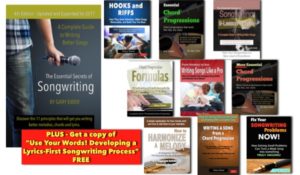Recently I wrote about the musical power that comes from starting progressions on a chord other than the tonic chord. By avoiding the tonic, the listener subconsciously wants to hear it, and so it creates a very powerful sense of musical energy: the listener is willing to wait to hear the tonic eventually happen.
 Songwriters are very familiar with the chorus hook, but there are other kinds to experiment with, and you will want to discover the power of layering various kinds of hooks in the same song. “Hooks and Riffs: How They Grab Attention, Make Songs Memorable, and Build Your Fan Base“ shows you how it’s done.
Songwriters are very familiar with the chorus hook, but there are other kinds to experiment with, and you will want to discover the power of layering various kinds of hooks in the same song. “Hooks and Riffs: How They Grab Attention, Make Songs Memorable, and Build Your Fan Base“ shows you how it’s done.
You can do the same thing with melodies. All melodies are made up of smaller bits called phrases, like this:
“Treat You Better” – (Shawn Mendes, Teddy Geiger, Scott Harris) KEY: Bb Minor
- Phrase 1: I won’t lie to you
- Phrase 2: I know he’s just not right for you
- Phrase 3: And you can tell me if I’m off but I can see it on your face
- Phrase 4: When you say that he’s the one that you want…
There’s a pleasant sense of forward motion that comes from the fact that even though the progression sits pretty solidly in the key of Bb minor (Bbm-Ab-Gb), the melodic bits — the phrases — that go together to form the first part of the verse melody all start and end somewhere other than the tonic note Bb: they all move in and around the notes F-Eb-Db.
That kind of avoiding of the tonic note does just what avoiding the tonic chord might do for a song: create a powerful sense of anticipation. In a way, it’s like a kind of musical “unrest”, where we want to hear the tonic, and are willing to wait for it.
Not every song needs to do this, of course. For example, the verse melody for Adele’s “Hello” consists of short phrases, all of which descend down to, and end on, the tonic note, before leaping upward again.
But that just goes to prove that there are many ways to create anticipation and musical energy that don’t necessarily apply to melodies.
But if you find that your melodies lack a certain kind of energy, you might try examining where the phrases of your verse melody start and end. If you find that the tonic note is too prevalent, perhaps overused, it may work to make some modifications to the starting and/or ending note.
 Written by Gary Ewer. Follow Gary on Twitter.
Written by Gary Ewer. Follow Gary on Twitter.
 “The Essential Secrets of Songwriting” eBook bundle comes with a free copy of “Use Your Words! Developing a Lyrics-First Songwriting Process,” along with a Study Guide. Learn how to make the writing of a good lyric the starting point for your own songwriting method.
“The Essential Secrets of Songwriting” eBook bundle comes with a free copy of “Use Your Words! Developing a Lyrics-First Songwriting Process,” along with a Study Guide. Learn how to make the writing of a good lyric the starting point for your own songwriting method.










